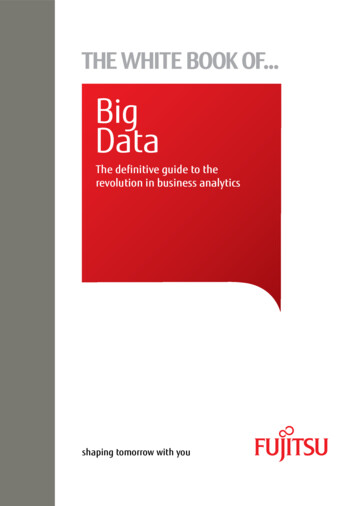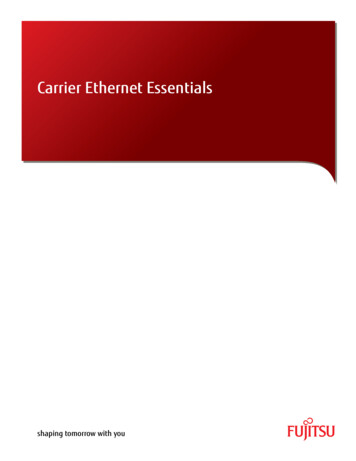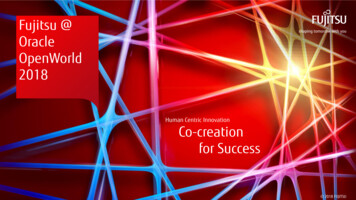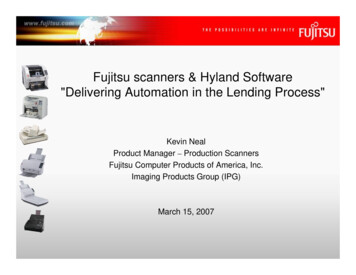
Transcription
BigDataThe definitive guide to therevolution in business analyticsshaping tomorrow with you
THE WHITE BOOK OF.BigDataThe definitive guide to therevolution in business analytics
THE WHITEBOOK OF Big DataContentsAcknowledgements 4Preface 51: What is Big Data? 62: What does Big Data Mean for the Business? 163: Clearing Big Data Hurdles 244: Adoption Approaches 325: Changing Role of the Executive Team 426: Rise of the Data Scientist 467: The Future of Big Data 488: The Final Word on Big Data 52Big Data Speak: Key terms explained 57Appendix: The White Book Series 60
AcknowledgementsWith thanks to our authors:l Ian Mitchell, Chief Architect, UK & Ireland, Fujitsul Mark Locke, Head of Planning & Architecture, International Business, Fujitsul Mark Wilson, Strategy Manager, UK & Ireland, Fujitsul Andy Fuller, Big Data Offering Manager, UK & Ireland, FujitsuWith further thanks to colleagues at Fujitsu in Australia, Europe and Japan who kindlyreviewed the book’s contents and provided invaluable feedback.For more information on Fujitsu’s Big Data capabilities and to learn how we can assist yourorganisation further, please contact us at askfujitsu@uk.fujitsu.com or contact your localFujitsu team (see page 62).ISBN: 978-0-9568216-2-1Published by Fujitsu Services Ltd.Copyright Fujitsu Services Ltd 2012. All rights reserved.No part of this document may be reproduced, stored or transmitted in any form without prior writtenpermission of Fujitsu Services Ltd. Fujitsu Services Ltd endeavours to ensure that the information inthis document is correct and fairly stated, but does not accept liability for any errors or omissions.
PrefaceIn economically uncertain times, many businesses and public sectororganisations have come to appreciate that the key to better decisions, moreeffective customer/citizen engagement, sharper competitive edge, hyperefficient operations and compelling product and service development isdata — and lots of it. Today, the situation they face is not any shortage ofthat raw material (the wealth of unstructured online data alone has swollenthe already torrential flow from transaction systems and demographicsources) but how to turn that amorphous, vast, fast-flowing mass of “BigData” into highly valuable insights, actions and outcomes.This Fujitsu White Book of Big Data aims to cut through a lot of the markethype surrounding the subject to clearly define the challenges andopportunities that organisations face as they seek to exploit Big Data.Written for both an IT and wider executive audience, it explores the differentapproaches to Big Data adoption, the issues that can hamper Big Datainitiatives, and the new skillsets that will be required by both IT specialistsand management to deliver success. At a fundamental level, it also showshow to map business priorities onto an action plan for turning Big Data intoincreased revenues and lower costs.At Fujitsu, we have an even broader and more comprehensive vision forBig Data as it intersects with the other megatrends in IT — cloud andmobility. Our Cloud Fusion innovation provides the foundation for businessoptimising Big Data analytics, the seamless interconnecting of multipleclouds, and extended services for distributed applications that supportmobile devices and sensors.We hope this book offers some perspective on the opportunities made realby such innovation, both as a Big Data primer and for ongoing guidanceas your organisation embarks on that extended, and hopefully fruitful,journey. Please let us know what you think — and how your Big Dataadventure progresses.Cameron McNaughtSenior Vice President and Head of Strategic SolutionsInternational BusinessFujitsu5
1WhatisBigData?
1What is Big Data?In 2010 the term ‘Big Data’ was virtuallyunknown, but by mid-2011 it was beingwidely touted as the latest trend, with allthe usual hype. Like ‘cloud computing’before it, the term has today been adoptedby everyone, from product vendors tolarge-scale outsourcing and cloud serviceproviders keen to promote their offerings.But what really is Big Data?In short, Big Data is about quickly deriving business value from a range ofnew and emerging data sources, including social media data, location datagenerated by smartphones and other roaming devices, public informationavailable online and data from sensors embedded in cars, buildings andother objects — and much more besides.Defining Big Data: the 3V modelMany analysts use the 3V model to define Big Data. The three Vs stand forvolume, velocity and variety.Volume refers to the fact that Big Data involves analysing comparativelyhuge amounts of information, typically starting at tens of terabytes.Photograph: iStockphotoVelocity reflects the sheer speed at which this data is generated andchanges. For example, the data associated with a particular hashtag onTwitter often has a high velocity. Tweets fly by in a blur. In some instancesthey move so fast that the information they contain can’t easily be stored,yet it still needs to be analysed.Data speedIn a Big Dataworld, one of thekey factors is speed.Traditional analyticsfocus on analysinghistorical data.Big data extendsthis concept toinclude real-timeanalytics of in-flighttransitory data.Variety describes the fact that Big Data can come from many differentsources, in various formats and structures. For example, social media sitesand networks of sensors generate a stream of ever-changing data. As wellas text, this might include, for example, geographical information, images,videos and audio.7
Linked Data: a new model for the databaseData sourcesBig Data not onlyextends the datatypes, but thesources that thedata is coming fromto include real-time,sensor and publicdata sources, as wellas in-house andsubscription sources.The growth of semi-structured data (see ‘Data types’, right) is driving theadoption of new database models based on the idea of ‘Linked Data’. Thesereflect the way information is connected and represented on the Internet, withlinks cross-referencing various pieces of associated information in a loose web,rather than requiring data to adhere to a rigid, inflexible format whereeverything sits in a particular, predefined box. Such an approach can provide theflexibility of an unstructured data store along with the rigour of defined datastructures. This can enhance the accuracy and quality of any query andassociated analyses.Value: the fourth vital VWhile the 3V model is a useful way of defining Big Data, in this book we will also beconcentrating on a fourth, vital V — value. There is no point in organisationsimplementing a Big Data solution unless they can see how it will give themincreased business value. That might not only mean using the data within theirown organisation — value could also come from selling it or providing access to thirdparties. This drive to maximise the value of Big Data is a key business imperative.There are other ways in which Big Data offers businesses new ways to generatevalue. For example, whereas traditional business analytical systems had tooperate on historical data that might be weeks or months out of date, a BigData solution can also analyse information being generated in ‘real time’ (or atleast close to real time). This can deliver massive benefits for businesses, as theyare able to respond more quickly to market trends, challenges and changes.Furthermore, Big Data solutions can add new value by analysing the sentimentcontained in the data rather than just looking at the raw information (for example,they can understand how customers are feeling about a particular product). This isknown as ‘semantic analysis’. There are also growing developments in artificialintelligence techniques that can be used to perform complex ‘fuzzy’ searches andunearth new, previously impenetrable business insights from the data.In summary, Big Data gives organisations the opportunity to exploit acombination of existing data, transient data and externally available datasources in order to extract additional value through:l Improved business insights that lead to more informed decision-makingl Treating data as an asset that can be traded and sold.It is therefore important that organisations keep sight of both the long-term goalof Big Data — to integrate many data sources in order to unlock even more8
1What is Big Data?Data typesIT people classify data according to three basic types: structured,unstructured and semi-structured.Structured data refers to the type of data used by traditional databasesystems, where records are split into well defined ‘fields’ (such as ‘name’,‘address’, etc) which can be relatively easily searched, categorised, sortedaccording to certain criteria, etc.Unstructured data, meanwhile, has no obvious pre-defined format, forexample image data or Twitter updates.Semi-structured data refers to a combination of the two types above.Some aspects of the data may be defined (typically within the informationitself, e.g. location data appended to social media updates) but overall itdoes not have the rigidity associated with structured data.potential value — while ensuring their current technology is not a barrier toaccuracy, immediacy and flexibility.In many respects Big Data isn’t new. It is a logical extension of many existingdata analysis systems and concepts, including data warehouses, knowledgemanagement (KM), business intelligence (BI), business insight and other areasof information management.The driveto maximisethe valueof Big Datais a keybusinessimperative.Big Data: the new ‘cloud’The trouble with all new trends and buzz-phrases is that they quickly become thelatest bandwagon for suppliers. As noted at the start of this chapter, all mannerof products and services are now being paraded under the ‘Big Data’ banner,which can make the topic seem incredibly confusing (hence this book). This iscompounded when vendors whose products might only pertain to a small part ofthe Big Data story grandly market them as ‘Big Data solutions’, when in factthey’re just one element of a solution. As a marketing term, then, be aware that‘Big Data’ means about as much as the term ‘cloud’ — i.e. not a great deal.When is ‘big’ really big?History tells us that yesterday’s big is today’s normal. Some over-40s readingthis book will probably remember wondering how they were ever going to fill the1 kilobyte of memory on their Sinclair ZX81. Today we walk around with tens of9
gigabytes of memory on our smartphones. Big Data simply refers to volumes ofdata bigger than today’s norm. In 2012, a petabyte (1 million gigabytes) seemsbig to most people, but tomorrow that volume will become normal, and – overtime — just a medium-to-small amount of data.What’s driving the need for Big Data solutions over traditional data warehousesand BI systems, therefore, isn’t some pre-defined ‘bigness’ of the data, but acombination of all three Vs. From a business perspective, this means ITdepartments need to provide platforms that enable their business colleaguesto easily identify the data that will help them address their challenges,interrogate that data and visualise the answers effectively and quickly (oftenin near real time). So forget size — it’s all about ‘speed to decision’. Big Data ina business sense should really be called ‘quick answers’.Near enough or mathematically perfect?IT departmentsneed to provideplatforms thatenable theirbusinesscolleagues toeasily identifythe data thatwill help themaddress theirchallenges.When the concept of Big Data first emerged, there was a lot of talk about‘relative accuracy’. It was said that over a large, fluid set of data, a Big Datasolution could give a good approximate answer, but that organisations requiringgreater accuracy would need a traditional data warehouse or BI solution. Whilethat’s still true to a degree, many of today’s Big Data solutions use the samealgorithms (computational analysis methods) as traditional BI systems,meaning they’re just as accurate. Rather than fixating on the mathematicalaccuracy of the answers given by their systems, organisations should insteadfocus on the business relevance of those answers.Big Data is so yesterdaySince Big Data has only been in common use since mid-2009, it might seemnatural to assume that early adopters face the usual slew of teething problems.However, this is not the case. That’s not because the IT industry has become anybetter at avoiding such problems. Rather, it’s because although the term ‘BigData’ may be relatively new, the concept is certainly not.Consider an organisation like Reuters (whose business model is based onextracting relevant news from a mass of data and getting it to the right peopleas quickly a possible) — it has been dealing with Big Data for over 100 years. Inmore recent years, so have Twitter, Facebook, Google, Amazon, eBay and a raftof other well-known online names. Today, the bigger problem is that so muchdata is thrown away, ignored or locked up in silos where it adds minimal value.Being able to integrate available data from different sources in order to extractmore value is vital to making any Big Data solution successful. Manyorganisations already have a data warehouse or BI system. However, thesetypically only operate on the structured data within an organisation. They10
1What is Big Data?seldom operate on fast-flowing volumes of data, let alone integrate operationaldata with data from social media, etc.Isn’t Big Data just search?A common misconception is that a Big Data solution is simply a search tool. Thisview probably comes from the fact that Google is a pioneer and key player in theBig Data space. But a Big Data solution contains many more features than simplysearch. Going back to our Vs, search can deal with volume and variability, but itcan’t handle velocity, which reduces the value it can offer on its own to a business.The IT bit: structure of a Big Data solutionCIOs are often concerned with what a Big Data solution should look like, how theycan deliver one and the ways in which the business might use it. The diagrambelow gives a simple breakdown of how such a solution can be structured. Thered box represents the solution itself. Outside on the left-hand side, are thevarious data sources that feed into the system — for example, open data (e.g.public or government-provided data, commercial data sites), social media (e.g.Twitter) or internal data sources (e.g. online transaction or analytical systems).Structure of a Big Data ientistsReports,Dashboards, onHistoricalAnalysisSearchData Access InterfaceSensorsData IntegrationSocial MediaMassive parallel analysisOpen DataConsumingSystemsStructured DataUnstructured DataData StorageBusinessPartnersPlatform Infrastructure11
The first function of the solution is ‘data integration’ — connecting the system tothese various data sources (using standard application interfaces and protocols).This data can then be transformed (i.e. changed into a different format for ease ofstorage and handling) via the ‘data transformation’ function, or monitored for keytriggers in the ‘complex event processing’ function. This function looks at everypiece of data, compares it to a set of rules and raises an alert when a match isfound. Some complex event processing engines also allow time-based rules (e.g.‘alert me if my product is mentioned on Twitter more than 10 times a second’).The data can then be processed and analysed in near real time (using ‘massivelyparallel analysis’) and/or stored within the data storage function for lateranalysis. All stored data is available for both semantic analysis and traditionalhistorical analysis (which simply means the data is not being analysed in realtime, not that the analysis techniques are old-fashioned).Search is also a key part of the Big Data solution and allows users to access datain a variety of ways — from simple, Google-like, single-box searches to complexentry screens that allow users to specify detailed search criteria.The data (be it streaming data, captured data or new data generated duringanalysis) can also be made available to internal or external parties who wish touse it. This could be on a free or fee basis, depending on who owns the data.Application developers, business partners or other systems consuming thisinformation do so via the solution’s data access interface, represented on theright-hand side of the diagram.Finally, one of the key functions of the solution is data visualisation — presentinginformation to business users in a form that is meaningful, relevant and easilyunderstood. This could be textual (e.g. lists, extracts, etc) or graphical (rangingfrom simple charts and graphs to complex animated visualisations).Furthermore, visualisation should work effectively on any device, from a PC to asmartphone. This flexibility is especially important since there will be a variety ofdifferent users of the data (e.g. business decision-makers, data consumers anddata scientists — represented across the top of the diagram), whose needs andaccess preferences will vary.12
1What is Big Data?Privacy and Big DataWith the rise of Big Data and the growing ease of access to vast numbers ofdata records and repositories, personal data privacy is becoming ever harder toguarantee – even if an organisation attempts to anonymise its data. Big Datasolutions can integrate internal data sets with external data such as socialmedia and local authority data. In doing so, they can make correlations thatde-anonymise data, resulting in an increased — and to many, worrying — abilityto build up detailed personal profiles of individuals.Today organisations can use this information to filter new employees, monitorsocial media activity for breaches of corporate policy or intellectual property andso on. As the technical capability to leverage social media data increases, wemay see an increase in the corporate use of this data to track the activities ofindividual employees. While this is less of a concern in countries such as the UKand Australia, where citizens’ rights to privacy and fair employment are a majorfocus, such issues are not uniformly recognised by governments around theworld. These concerns have led to a drive among privacy campaigners and EUdata protection policy-makers towards a ‘right to forget’ model, where anyonecan ask for all of their data to be removed from an organisation’s systems andbe completely forgotten.Many of the concerns are borne out of stories such as people being turned downfor a job because an employer found a comprising picture of them on Facebook,or companies sacking people for something they’ve posted in a private capacityon social media. But as today’s younger generation becomes the managementof tomorrow, it is likely to be more relaxed about both data privacy issues, andabout what employees reveal about what they get up to in their own time. As aresult, we’re likely to see a move towards more of a ‘right to forgive’ model —where individuals feel able to place more trust in organisations not to misusetheir data, and those organisations will be less likely to do so.With the riseof Big Datapersonal dataprivacy isbecomingever-harderto guarantee– even if anorganisationattempts toanonymisethe data.The generation that has grown up with social media understands, for example,that if a photograph of someone inebriated at a party is posted on Facebook,it doesn’t mean that person is an unworthy employee. Once such a more relaxedattitude to personal privacy becomes pervasive, data will become moreaccessible as people trust it won’t be misinterpreted or misused by businessesand employers.So when is the right time to adopt a Big Data solution? Just as has happenedwith mobile phones, our dependency on data will increase over time. This willcome about as consumers’ trust in the data grows in line with it becoming both13
more resilient and more accessible. Given that Big Data is not actually new (asdiscussed earlier), late adopters may — surprisingly quickly — come to suffer thenegative business consequences of not embracing it sooner.The new KM modelFor the past decade or so, businesses have often categorised data according to atraditional knowledge management (KM) model known as the DIKW hierarchy(data, information, knowledge, wisdom). In this model, each level is built fromelements contained in the previous level. But in the context of Big Data, thisneeds to be extended to more accurately reflect organisations’ need to gainbusiness value from their (and others’) data. A better model might be:l Integrated data — data that is connected and reconnected to make itmore valuablel Actionable information — information put into the hands of thosethat can use itl Insightful knowledge — knowledge that provides real insight(i.e. not just a stored document)l Real-time wisdom — getting the answer now, not next week.Of course, some organisations have put significant investment into traditionalknowledge management systems and processes. So in regard to KM and itsrelationship with Big Data, it is worth noting the following:1. KM is an enabler for Big Data, but not the goal2. KM activities achieve better outcomes for structured data than for unstructuredor semi-structured data3. The principles of KM are still important but they need to be interpreted in newways for the new types of data being processed4. KM focuses much effort on storing all data, but that is not always the focuswith Big Data, particularly when analysing ‘in-flight’ (transient) data.In that sense Big Data has a librarian’s focus. The archivist wants to store databut is less interested in making it accessible. The librarian is less interested instoring data as long as he or she has access to it and can provide theinformation that their clients need.14
1What is Big Data?Hadoop: the elephant in the roomIn a conversation about Big Data, it won’t be long before someone (usuallythe techie in the room) mentions Hadoop. Hadoop is an open sourcesoftware product (or, more accurately, ‘software library framework’) that iscollaboratively produced and freely distributed by the Apache Foundation –effectively, it is a developer’s toolkit designed to simplify the building of BigData solutions.In technical terms, Hadoop enables distributed processing of large data setsacross clusters of computers using a simple programming model. It can beextended with other components to create a Big Data solution. It is popular(as is most Apache Foundation software) because it works and it is free.If this all sounds too good to be true, it’s worth remembering thatdownloading the software is only the start if you want to build your own BigData solution. In some cases, Hadoop projects distract businesses away fromusing Big Data to solve their business problems faster and instead temptthem onto the rocky road of developing their ‘ideal Big Data solution’ –which often ends up delivering nothing.In short, Hadoop provides an important technical capability but it is merelyone enabler for a complete Big Data solution (it incidently doesn’t addressthe kind of semi-structured data challenge that a Linked Data solution isdesigned to handle). It is the capabilities beyond Hadoop that provide thereal differentiator for Big Data solutions. Businesses should instead look outfor cloud-based Big Data solutions which are scalable and offer ‘try-beforeyou-commit’ features, not to mention an extensive range of built-in features.Towards successful implementationThe key to successfully implementing a Big Data solution is to identify thebenefits and pitfalls in advance and ensure it meets company objectives whilealso laying a foundation for broader business exploitation of the data in the future.The following chapters will examine in more detail how to go about this.15
2WhatdoesBigDataMeanfortheBusiness?
2What does Big Data Mean for the Business?Every organisation wants to make the bestinformed decisions it can, as quickly as it can.Indeed, gleaning insights from data in as close toreal time as possible has been a key driving forcebehind the evolution of modern computing. Forexample, the very first computers — developed in theUK by World War II code-breakers — were designed tocrack encrypted enemy communications fast enoughto inform critical military and political decisions.Back then, any failure to do so could have potentiallyfatal consequences.After the war, organisations began to realise that computing was also the key tosecuring business advantage — giving them the opportunity to work more quicklyand efficiently than their competitors — and the IT industry was born.Photograph: CorbisToday IT has spread beyond the confines of the military, government and business,playing a part in almost every aspect of people’s lives. The consumerisation of IThas meant that most people in developed societies now own powerful, connectedcomputing devices such as laptops, tablet PCs and smartphones. Combined withthe growth of the Internet, this means an immense and exponentially growingamount of data is being generated — and is potentially available for analysis. Thisencompasses everything from highly structured information, such as governmentcensus data, to unstructured information, such as the stream of comments andconversations posted on social networks.The challengefor organisationsnow is to achieveinsightful resultslike those ofwartimecode-breakers.The challenge for organisations now is to achieve insightful results like those of thewartime code-breakers, but in a very much more complicated world with manyadditional sources of information. In a nutshell, the Big Data concept is aboutbringing a wide variety of data sources to bear on an organisation’s challenges andasking the right type of questions to give relevant insights — in as near to real timeas possible. This concept implies:l Data sets are large and complex, consisting of different information types andmultiple sources17
l Data is relevant up to the secondl Data collection is automated and takes place in real time from people,systems, instruments or sensorsl Analytical techniques enable organisations to anticipate and responddynamically to changing events and trendsl Benefits may apply to individuals, organisations and across society.The challenge isto find gold inthe ever-growingmountain ofinformation andact on it in nearreal time.For different businesses and roles, this will mean different things. How someoneassesses and balances factors such as value, cost, risk, reward and time whenmaking decisions will vary according to their particular organisational andoperational priorities. For example, sales and marketing professionals might focuson entering new markets, winning new customers, increasing brand awareness,boosting customer loyalty and predicting demand for a new product. Operationspersonnel, meanwhile, are more likely to concentrate on ensuring theirorganisations’ processes are as optimal and efficient as possible, with a focus onmeasuring customer satisfaction.Finding gold in the data mountainsAll these drivers for business success depend on information. But today the quantityof information available is not the issue. As the world has increasingly moved online,people’s activities have left a trail of data that has grown into a mountain. Thechallenge is to find gold in that ever-growing mountain of information byunderstanding and acting on it in near real time. Companies already adept at doingso include the likes of Google, Amazon, Facebook and LinkedIn.But an organisation doesn’t need to be an Internet giant to benefit from Big Data— and successful solutions aren’t always vast, expensive exercises that take monthsto implement. Even a simple mashup (where someone thinks laterally, bringingtogether two or three different sources of information and applies them to aproblem) can give a unique and fresh perspective on data that delivers clarity to aproblem and allows an organisation to take instant action.For example, how do supermarkets ensure there’s plenty of barbecue meat on theshelves whenever the weather is fine? They do it by combining and analysing datathey own and control (such as that from sales, loyalty card and logistics systems)with long range weather forecast data, as well as an understanding of suppliers’ability to meet any surges in demand for certain products. That’s a fairly simpleexample, but more and more organisations are looking into their information hoardto see if it can be turned into a library for use today or in the future.18
2What does Big Data Mean for the Business?An explosion of information sourcesThe variety of available information sources is growing rapidly. As well as socialmedia data, for example, there’s telemetry data generated by cars, GPS datagenerated by smartphones, information collected on individuals and organisationsby banks and governments — and much more data is coming on stream all the time.The question is how all these sources can be applied in a way that is not onlybeneficial to a business but also allows people to trust in the integrity of theorganisations and institutions collecting, handling, integrating, analysing andacting on that data. In addition, businesses must understand the implicationsof relying on particular data sources, and what they would do if these becameunavailable for any reason.Big data in actionToday there are many examples of Big Data applications in action — both in a socialand business context. From agriculture and transport to sustainability, health andleisure, Big Data has implications for just about every aspect of business andpeople’s lives. For instance:l Financial services organisations can use it to detect fraud and improve theirdebt positionl Leisure companies can examine data across their franchises of theme parks,hotels, restaurants, etc, lookin
optimising Big Data analytics, the seamless interconnecting of multiple clouds, and extended services for distributed applications that support mobile devices and sensors. We hope this book offers some perspective on the opportunities made real by such innovation, both as a Big Data primer and for ongoing gu











